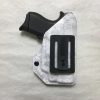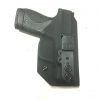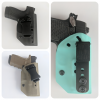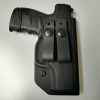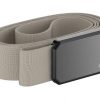What is concealed carry?
Concealed carry is the act of having a firearm holstered and hidden from plain sight on your person while in public. This is opposed to what is called open carry, which is the act of having a firearm holstered on your person, but in plain sight. Most states offer the ability for citizens to obtain a concealed carry permit and some states offer open carry possibilities, with or without a permit. If you are considering carrying a concealed firearm, you should examine these critical issues:
Mindset
There are many reasons why people choose to carry a concealed firearm. Maybe your neighborhood has seen an uptick in crime recently and you refuse to be a prisoner in your own home. Maybe you are a new mother and your protective instincts are kicking into overdrive. Maybe you are a concerned citizen and wish to exercise your 2nd Amendment right on a daily basis. No matter the reason you choose to carry a concealed firearm, you must be able to confront the psychological realities of using deadly force to protect yourself and your loved ones. Additionally, if you are ever in the unfortunate position of having had to use a firearm in self-defense, you can be sure that legal, and possibly social, issues will be next on your list of obstacles to tackle. Study the laws in your state thoroughly. One good starting point is the book Traveling the 50 States.
Legality
Before you can carry a concealed weapon, you must be sure that you are legally allowed to do so in your state. Each state has different training and permitting requirements. Once you receive your permit, you should closely examine the limitations on where you can legally carry your firearm. Some places, like federal government buildings and airports, are generally off limits even to those with valid permits. Other places, like restaurants and colleges, depend on state and local law. Finally, you should understand the legal issues involved with using a firearm in self-defense.
Clothing and Concealment
Depending on your personal style, concealing a firearm on your person may be challenging. You may have to wear pants with a bit more space in the waistline to accommodate a holster and firearm. You may need to wear more patterned shirts to help deal with “printing” – the outline of the firearm and/or holster showing on the outside of a garment. If you like to wear tight fitting clothing, you may need to consider off-body carry options, such as a concealed carry purse. Each person has a different body type and clothing style, but everyone should be able to find a comfortable and concealable method to use on a daily basis. AthenasArmory.com offers a variety of holsters and alternative carry methods.
Holsters
Selection of a holster and carry method is not an easy task. Chances are, you will need a variety of holster styles to accommodate changes in wardrobe and carry method. The most popular carry location is on the hip, either inside or outside the waistband, but many people choose to carry in the front, called appendix carry, the small of their back, around the ankle, in a bra, under the shoulder, or even on the thigh. Your carry location will depend on your daily activities, your need for quick access, clothing style, and your comfort level with each type. In addition to different carry locations, holsters are made from many different materials, have different attachment options, and combine with other items in a modular way to accommodate different situations.
Handgun Selection
Most handguns can be concealed with the right holster and clothing choices. However, each person has unique self-defense preferences, style choices, and physical limitations. It will much more difficult for an 80 lb. woman to conceal a full-size 1911 than a sub-compact 9mm. The physical dimensions and weight (plus ammunition) of various handguns make some more ideal for concealed carry than others. Generally speaking, the most popular concealed carry handguns tend to be a bit smaller in size and use polymer frames to reduce weight. It is important to remember that reduced size and weight usually results in increased perceived recoil, which can affect accuracy. Each person must weigh all the different factors and choose a firearm that is best for their needs.
Training
Basic shooting fundamentals and an insistence upon strict firearm safety are critical any time you are handling a firearm, but are especially important when you make the decision to concealed carry on a daily basis. Just because you have the permit does not mean you are well practiced and ready to defend yourself if needed. Ongoing training and dry-fire practice at home, as well as working on your draw stroke and re-holstering are critical to maintaining good habits and muscle memory. Statistics show that 750 repetitions are necessary for proper muscle memory to occur. If you haven’t reached this level of training yet, it’s OK, just keep on trucking.
As you can see, there are many important issues to consider when making the decision to carry a concealed firearm on a daily basis.





